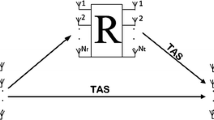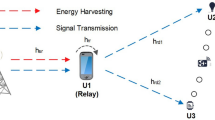Abstract
The Bit Error Rate (BER) of a single user cooperative Impulse Radio (IR)-Ultrawideband (UWB) communication system employing Energy Detector (ED) receiver with On-Off Keying (OOK) in IEEE 802.15.4a UWB multipath environment is investigated in this paper. Analytical evaluation based on Energy detection principle is performed to derive approximate BER Expressions for various diversity combining cases, namely optimum combining, linear combining and selective combining using cooperative dual-hop Detect and Forward (DTF) relay protocol in presence and absence of Inter-symbol interference (ISI). Numerical results reveal that there is a significant improvement in BER, with increase in number of relay diversity paths and decrease in number of frames Nf. The accuracy and perfection in approximation used in investigation of BER is confirmed with the validation of the analytical BER expressions with that of the simulation results. The analytical and simulation results confirm that among the diversity combining schemes, the performance of optimum combining is better compared with linear combining, which in turn performs better than selective combining.








Similar content being viewed by others
References
Federal Communications Commission (FCC) (2002) Revision of part 15 of the commission’s rules regarding ultra-wideband transmission systems First Report and Order, ET Docket 98-153, FCC 02-48 Adopted: February 2002; Release
Zeinalpour-Yazdi Z, Nasiri-Kenari M, Aazhang B (2010) Bit error probability analysis of UWB communications with a relay node. IEEE Trans Wirel Commun 9(2):802–813
Sendoris A, Erkip E, Aazhang B (2003) User cooperative diversity part I: System description. IEEE Trans Commun 51(11):1927–1938
Lanemann J N, Tse D N C, Wornell G W (2004) Cooperative diversity in wireless networks: efficient protocols and outage behavior. IEEE Trans Inf Theory 51(12):3062–3080
Hazra R, Tyagi A (2014) Cooperative impulse radio ultra-wideband communication using coherent and non-coherent detectors: a review, wireless personal communications. Springer 77(1):719–748
Van Der Meulen E C (1971) Three terminal communication channels. Adv Appl Probab 3(1):120–154
Cover T M, El Gamal A A (1979) Capacity theorems for the relay channel. IEEE Trans Inf Theory 25 (5):572–584
Cassioli D, Win M Z, Vatalaro F, Molisch A F (2002) Performance of low complexity Rake reception in a realistic UWB channel. In: IEEE international conference on communications, ICC, vol 2, pp 763–767
Romme J, Witrisal K (2006) Transmitted reference UWB systems using weighted autocorrelation receivers. IEEE Trans Microw Theory Tech 54(4):1754–1761
Abou-Rjeily C, Daniele N, Belfore J C (2008) On the amplify-and-forward cooperative diversity with time hopping ultra-wideband communications. IEEE Trans Commun 56(4):630–641
Abou-Rjeily C, Daniele N, Belfore JC (2006) On the decode and forward cooperative diversity with coherent and non-coherent UWB systems. In: Proceedings of IEEE international conference on ultrawideband, pp 435–440
Abou-Rjeily C (2013) A symbol by symbol cooperative diversity scheme for relay-assisted UWB communications with PPM. IEEE J Select Areas Commun 31(8):1436–1445
Kundu C, Bose R (2014) Performance of a multi-hop UWB transmitted reference system using decode and forward relays, Wireless personal communications. Springer 77(3):1801–1814
Hamdi M, Mietzner J, Schober R (2010) Double differential encoding for dual-hop amplify-and-forward relaying in IR-UWB systems. In: Proceedings of IEEE 7st vehicular technology conference VTC
Hamdi M, Mietzner J, Schober R (2011) Multiple-differential encoding for multi-hop amplify-and-forward IR-UWB systems. IEEE Trans Wirel Commun 10(8):2577–2591
Bai Z, Xu Y (2012) MGF based performance analysis of dual-hop regenerative relaying IR-UWB system. AEU-Int J Elect Commun 66(8):641–646
Hazra R, Tyagi A (2014) A survey on coherent and non-coherent IR-UWB receivers, wireless personal communications. Springer 79(3):2339–2369
Hazra R, Tyagi A (2014) Performance analysis of IR-UWB TR receiver using cooperative dual hop AF strategy. In: Proceedings of advances in computing, communications and informatics, ICACCI, pp. 2537–2543. https://doi.org/10.1109/ICACCI.2014.968441
Jin Y, Kwak K S (2017) A transmitted reference pulse cluster averaging UWB receiver. IEEE Syst J 11 (2):1107–1115
Liang Z, Dong X, Gulliver T A, Liao X (2014) Performance of transmitted reference pulse cluster ultra-wideband systems with forward error correction. Int J Commun Syst, Wiley 27(2):265–276
Gishkori S, Leus G (2013) Compressive sampling based energy detection of ultra-wideband pulse position modulation. IEEE Trans Signal Process 61(15):3866–3879
Jung S Y (2013) Design of preamble signal for synchronization in ultra-wideband noncoherent energy detection receivers. Int J Commun Syst, Wiley 26(4):465–480
D’ Amico A A, Mengali U, Arias-de-Reyna E (2007) Energy-detection UWB receivers with multiple energy measurements. IEEE Trans Wirel Commun 6(7):2652–2659
Yang L, Giannakis G B, Swami A (2007) Noncoherent ultra-wideband (de) modulation. IEEE Trans Commun 55(4):810– 819
Franz S, Mitra U (2003) Generalized UWB transmitted reference systems. IEEE J Select Areas Commun 24(4):780–786
Quek T Q S, Win M Z, Dardari D (2007) Unified analysis of UWB transmitted reference schemes in presence of narrowband interference. IEEE Trans Wirel Commun 6(6):2126–2138
Luo X, Giannakis G B (2006) Achievable rates of transmitted-reference ultra-wideband radio with PPM. IEEE Trans Commun 54(9):1536–1541
Mondelli M, Zhou Q, Ma X, Lottici V (2012) A cooperative approach for amplify and forward differential transmitted reference IR-UWB relay systems. In: Proceedings of IEEE international conference on acoustics, speech and signal processing, ICASSP, pp 2905–2908 Japan
Cui S Modulation and multiple access techniques for ultra-wideband communication systems, Ph.D dissertation, Cleveland State University
Cheng X, Guan Y L (2009) Mitigation of cross-modulation interference in UWB energy detector receivers. IEEE Commun Lett 13(6):375–377
Win M Z, Scholtz R A (2000) Ultra-wide bandwidth time-hopping spread spectrum impulse radio for wireless multiple-access communication. IEEE Trans Commun 48(4):679–691
Saleh A, Valenzuela R (1987) A statistical model for indoor multipath propagation. IEEE J Select Areas Commun 47(9):128–137
Molisch AF et al (2004) IEEE 802.15.4a channel model report
Proakis J (2004) Digital communications. McGrawHill, New York, pp 288–292. 2001.o
Author information
Authors and Affiliations
Corresponding author
Additional information
Publisher’s note
Springer Nature remains neutral with regard to jurisdictional claims in published maps and institutional affiliations.
Appendices
Appendix A: Determination of variance of \({n_{k}^{2}}(t)\)
Let u = nSD(t),nSR(t),nRD(t) and v = u2. Therefore, the variance of v can be simplified as:
where \(\mathbb {E}[u]=0\) and \({{\sigma }_{u}^{2}}=\frac {N_{0}}{2}\). The term \(k \in \left \{1,2,3\right \}\) represents S-D, S-R and R-D link respectively as mentioned already.
Appendix B: Determination of optimum combining factor ζ
-
i.
Correct Detection: In order to evaluate the value of ζ, we differentiate the SNR expression given by Eq. (54) w.r.t. ζ and equate the result to 0.
$$ \begin{array}{@{}rcl@{}} \frac{d{\gamma}_{LOC}}{d\zeta} &=& \frac{(A-B)}{C} = 0, \end{array} $$(64)where \(A = 2(s_{SD}+\zeta s_{RD})s_{RD}({\sigma }_{Z_{\text {noise}-SD}}^{2}+\zeta ^{2}{\sigma }_{Z_{\text {noise}-RD}}^{2})\), \(B=(s_{SD}+\zeta s_{RD})^{2}2\zeta ({\sigma }_{Z_{\text {noise}-RD}}^{2})\) and \(C=({\sigma }_{Z_{\text {noise}-SD}}^{2}+\zeta ^{2}{\sigma }_{Z_{\text {noise}-RD}}^{2})^{2}\).
$$ \begin{array}{@{}rcl@{}} \frac{d{\gamma}_{LOC}}{d\zeta} &=& 2[(s_{SD}+\zeta s_{RD})s_{RD}({\sigma}_{Z_{\text{noise}-SD}}^{2}\\&&+\zeta^{2}{\sigma}_{Z_{\text{noise}-RD}}^{2})]-[(s_{SD}+\zeta s_{RD})^{2}\\&&\times 2\zeta{\sigma}_{Z_{\text{noise}-RD}}^{2}] = 0. \end{array} $$(65)Using quadratic rule, we find the roots for ζ.
$$ \begin{array}{@{}rcl@{}} \zeta &=& \frac{-4({\sigma}_{Z_{\text{noise}-SD}}^{2})s_{RD}^{2}}{-4s_{SD}s_{RD}{\sigma}_{Z_{\text{noise}-RD}}^{2}} = \frac{({\sigma}_{Z_{\text{noise}-SD}}^{2})s_{RD}}{({\sigma}_{Z_{\text{noise}-RD}}^{2})s_{SD}}. \end{array} $$(66) -
ii.
Incorrect Detection: In order to evaluate the value of ζ, we differentiate the SNR expression given by Eq. (56) w.r.t. ζ and equate the result to 0. Following the same procedure as above, we obtain the value of ζ.
Appendix C: Determination of optimum combining factor ζ in presence of ISI
-
i.
Correct Detection: To solve the value of ζ, we differentiate the SNR expression given by Eq. (53) w.r.t. ζ and equate the result to 0.
$$ \begin{array}{@{}rcl@{}} \frac{d{\gamma}_{LOC-ISI}}{d\zeta} &=& \frac{(A_{1}-B_{1})}{C_{1}} = 0, \end{array} $$(67)where \(A_{1}=2(s_{SD}+\zeta s_{RD})s_{RD}({\sigma }^{2}_{Z_{\text {noise}-SD}}+\zeta ^{2}{\sigma }^{2}_{Z_{\text {noise}-RD}}+I_{SD}+\zeta I_{RD})\), \(B_{1}=(s_{SD}+\zeta s_{RD})^{2}2\zeta ({\sigma }^{2}_{Z_{\text {noise}-RD}}+I_{RD})\) and \(C_{1}=({\sigma }^{2}_{Z_{\text {noise}-SD}}+\zeta ^{2}{\sigma }^{2}_{Z_{\text {noise}-RD}}+I_{SD}+\zeta I_{RD})^{2}\).
$$ \begin{array}{@{}rcl@{}} \frac{d{\gamma}_{LOC-ISI}}{d\zeta} &=& 2[(s_{SD}+\zeta s_{RD})s_{RD}({\sigma}^{2}_{Z_{\text{noise}-SD}}\\&&+\zeta^{2}{\sigma}^{2}_{Z_{\text{noise}-RD}}+I_{SD}+\zeta I_{RD})]\\&&-[(s_{SD}+\zeta s_{RD})^{2}(2\zeta{\sigma}^{2}_{Z_{\text{noise}-RD}}+I_{RD})] \\&& = 0. \end{array} $$(68)Using quadratic rule, we find the roots for ζ.
$$ \begin{array}{@{}rcl@{}} \zeta &=& \frac{-2b_{1}\pm 2\sqrt{{b_{1}^{2}}-a_{1}c_{1}}}{2a_{1}}, \end{array} $$(69)where \(a_{1}=s_{RD}^{2}I_{RD}-2s_{SD}s_{RD}{\sigma }^{2}_{Z_{\text {noise}-RD}}\), \(b_{1}=s_{RD}^{2}({\sigma }^{2}_{Z_{\text {noise}-SD}}+I_{SD})-s_{SD}^{2}{\sigma }^{2}_{Z_{\text {noise}-RD}}\) and \(c_{1}=2s_{SD}s_{RD}({\sigma }^{2}_{Z_{\text {noise}-SD}}+I_{SD})-s_{SD}^{2}I_{RD}\).
-
ii.
Incorrect Detection: In order to evaluate the value of ζ, we differentiate the SNR expression given by Eq. (57) w.r.t. ζ and equate the result to 0. Following the same procedure as above, we obtain the value of ζ.
Rights and permissions
About this article
Cite this article
Hazra, R., Tyagi, A. Bit error probability analysis of IR-UWB ED-OOK system using cooperative dual-hop DTF strategy. Ann. Telecommun. 75, 381–395 (2020). https://doi.org/10.1007/s12243-020-00764-5
Received:
Accepted:
Published:
Issue Date:
DOI: https://doi.org/10.1007/s12243-020-00764-5




